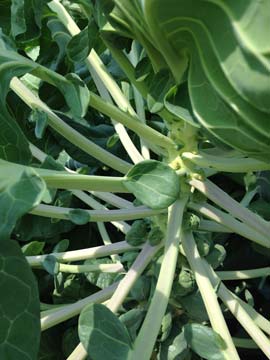 Brussels Sprouts enjoy a frost
Brussels Sprouts enjoy a frost
Just when you have put all the seedlings into the ground and they are happily growing, it is time to think fall! Some classic fall vegetables like Brussels sprouts and parsnips take 75 - 100 days to grow to maturity. Brussels sprouts, kale, and broccoli can all take a little frost and in the case of kale and Brussels sprouts, the first heavy frost makes them sweeter. Counting back from your average first fall frost date to the starting date for these items is easier with a Julian calendar which accrues the dates of the year from January 1st onward – it is easy to find online. Using this calendar October 1st is day 274. Most of us have a first fall frost sometime in October so add or deduct to your specific first frost date. Catskill Brussel Sprouts take about 100 days to mature which makes the start date for them on, or after, day 174 which is the end of June.
Most of the US is warm by July and the ideal temperature for germination for the cabbage family is 55-65⁰ which makes germination quicker indoors where it is cool. When the seedlings have 4 true leaves, transfer them to a shady place in the garden. Put them under the shade of summer beans or use a shade cloth to keep the plants cool through the worst of the summer heat. Remove the shade cloth toward the end of August for the plants to get full sun. Fertilize the seedlings when they are ready to join the rest of the garden.
 Typical fall harvest of carrots, kale and Brussel sprouts
Typical fall harvest of carrots, kale and Brussel sprouts
Several crops do not like frost and will not grow well in hot summer temperatures either. Timing these plantings can be a bit trickier. Snap peas for example enjoy the cooler weather of late September and October but they only take 65 days or so to mature. This puts their start at the beginning of August in the garden where they are sown directly into the ground to germinate and then really take off when the temperatures moderate. Lettuce matures in even less time (45-70 days) and can be started as late as early September in warmer climates.
Spinach, carrots, cabbages and beets all enjoy cooler fall weather, and if started in mid to late summer will provide you with fresh vegetables from the garden, well into fall.
Kate Copsey, Garden Writer and Author